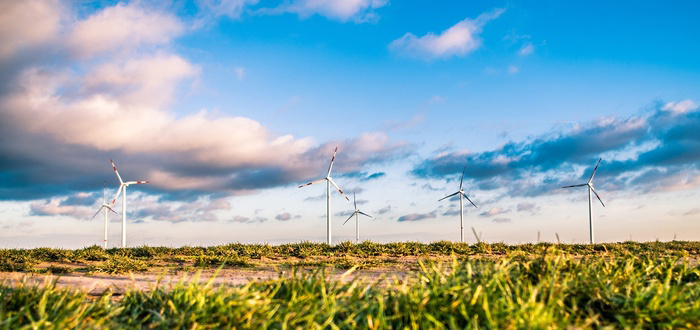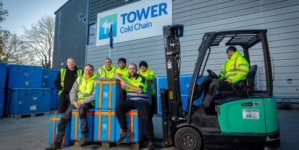-
Nutrivend selects Forterro’s Orderwise to support online expansion and streamline operations - April 11, 2025
-
ARROWXL LAUNCHES AMBITIOUS ZERO WASTE ROADMAP - April 8, 2025
-
THE BCMPA’S NEW CAMPAIGN DRIVES OUTSOURCING SUCCESS IN Q1 - April 7, 2025
-
BLACKOUT TECHNOLOGIES TARGETS TELEMATICS-INTEGRATED MOBILE DEVICE BLOCKING TO COMBAT SMARTPHONE DISTRACTION - April 1, 2025
-
Sparck Technologies awarded Royal designation - March 27, 2025
-
OpenADR Alliance announces first OpenADR 3.0 certified products with EVoke Systems, E.ON Energy and Universal Devices - March 25, 2025
-
Growing fulfilment and contract packer appoints new Managing Director - March 25, 2025
-
When is it time to invest in a WMS? Understanding the key trigger points - March 25, 2025
-
eCapital helps Vantage Recruitment on its journey to financial success - March 24, 2025
-
Hugo Beck Celebrates 70 Years of Packaging Innovation with Open House Events - March 20, 2025
How data can help build a sustainable supply chain.
When Dun & Bradstreet held a customer advisory forum this fall, they asked procurement professionals about their biggest pain points. Leading the list: having a sustainable supply chain and rooting out bribery and corruption in their supply chains.
“Our companies are asking for ways to identify suppliers to help them meet sustainability criteria or diversity criteria,” said Brian Alster, global head of compliance and supply at Dun & Bradstreet.
That’s hard to do in this economy, where products and raw materials are sourced globally and each supplier tier brings new risks.
What makes it easier? The proliferation of big data and technology, which increasingly is used to identify supply chain risks that can flag areas where companies need to improve.
Managing and automating supplier data
“When we’re talking to customers about how they can improve their supply chain for sustainability, everything starts with mastering the data,” Alster said. Using supplier data from multiple systems across multiple lines of business is best after aggregating and cleansing it. The same supplier may use different names or addresses depending on the products, or have hidden ownership relationships.
One advantage to using a software system that compiles vendor information is the possibility of accessing third party supplier data through a shared database. The supply chain staff can add in new supplier data when onboarding or updating suppliers.
Specialized apps or software can filter and segment various risks, showing specific documentation needed to confirm a company’s status as a green company or diversity-owned company, for example. Dun & Bradstreet’s human trafficking risk index is one example.
When we’re talking to customers about how they can improve their supply chain for sustainability, everything starts with mastering the data.
Brian Alster
Global Head of Compliance and Supply at Dun & Bradstreet
“We can identify potential risks in your supply chain based on the industry of your supplier, geographic location, how large they are, and whether they have a higher or lower propensity for forced labor. Those tools help them determine who to ask questions to,” Alster said. If a company is procuring clothing from supplier in region in China, for example, the buyer may need to ask more questions about forced labor than they would from a Vermont-based supplier. “We help identify where to dig deeper.”
Alster said they can do the same when looking into corruption and bribery risks. “Part of procurement organization’s primary goal is to protect the brand. We can provide specific types of screening for adverse media and criminal allegations, to make sure the company you want to do business with has historically not been caught doing things that can harm your brand,” he said.
It’s easier to make sustainability changes in a supply chain, with accurate data. When LLamasoft started incorporating third party data like greenhouse gas metrics for various transportation modes, they had to standardize measures from different programs. By using one yardstick, customers could better understand how their supply chain and operations affect their carbon footprint.
We can provide specific types of screening for adverse media and criminal allegations, to make sure the company you want to do business with has historically not been caught doing things that can harm your brand.
Brian Alster
Global Head of Compliance and Supply at Dun & Bradstreet
“When doing a project to optimize inventory, network structure or product flow, they could see how it impacts emissions,” said Toby Brzoznowski, EVP and co-founder of LLamasoft.
Using the data and running different scenarios, companies can find the best balance. A company producing something in Europe might get lower emissions rates by producing and storing products in France, closer to the major markets. France’s geothermal and nuclear power provides a lower carbon footprint, but labor and operating costs increase significantly.
Locating a facility in the Czech Republic lowers labor and operating costs, but the carbon footprint dramatically increases, as they primarily use coal energy.
Other technology companies have also stepped into this area to offer applications to help with rating, tracking and maintenance of supplier relationships. EcoVadis provides sustainability information from more than 30,000 suppliers globally, in 21 categories from biodiversity to water use, to health and safety, to ethics.
How data affects subsequent supply chain tiers
Understanding sub-tiers of suppliers is a big opportunity in the procurement industry, Alster said, using N-tier analysis.
“We’re doing more of that these days,” he said. “It’s providing a level of clarity that hasn’t been around before.”
Dun & Bradstreet worked with companies to drill down to the sixth tier, involving hundreds of thousands of suppliers. The only way to do that is if the companies and their respective suppliers provide the needed information. It can be difficult, given that many companies have a large, global and diverse supply chain, like auto manufacturers and big box retailers.
Working with partners
Asking suppliers direct questions is helpful, but doesn’t always provide enough information. Companies like 3M rely on partners with local and specific expertise to help with their supply chain’s sustainability information, in areas like forestry and conflict minerals. 3M works with The Forest Trust (TFT) for pulp and paper traceability, given deforestation and community rights concerns. They use the Responsible Minerals Initiative as their conflict minerals partner.
Tracking conflict minerals to their source to ensure there’s no forced labor or human trafficking involved in procurement is difficult for 3M to do on their own. Companies find it better to combine forces to share the work and intelligence, even if that means working with competitors on these issues.
“We’re not interested in competing with other companies on the sustainability of the supply chain. We present it as a value to our customers, that they can trust us,” said John Ostergren, director of EHS at 3M.
In addition to using partners, companies like 3M pull sustainability information from other sources, like international labor organizations and governments tracking environmental or labor risks.
Certifying sustainability
Sustainability certifications are proliferating at the corporate level, the product level and the supply chain level, said Dawn Krueger, sustainability supply chain manager at 3M. Certifications are only helpful to a point, though.
“It doesn’t seem to matter how many certifications you throw in front of people. They say ‘that’s great, we still want to come in and see your operations and do our audit,’” she said.
A company has to weigh their available resources to obtain certifications, versus using those resources to improve their sustainable supply chain. That said, 3M is happy to be included in the Dow Jones Sustainability Index for 18 years, and to be in the CSR top tier in the Gartner rankings.
While not a certification, other rankings include EcoVadis’s 2017 Global CSR Risk and Performance Index, which evaluated almost 22,000 companies for global supply chain risks in 21 categories. While end-users may not care about a company’s sustainability efforts, procurement organizations make it clear that there’s a business case for it. “If you want to grow your business or retain contracts with Fortune 500 companies, you have no option,” said Pierre-Francois Thaler, co-founder and co-CEO of EcoVadis.
How popular is sustainability?
Ask a company if it places a high level of importance on sustainability, and 97% will say yes, according to companies surveyed in the EcoVadis 2017 Sustainable Procurement Barometer report.
Sustainability is important enough that for the last five to ten years, the job is generally handled by a top-level executive, with board room level participation, Brzoznowski said. “The design of the supply chain and operations is part of the corporate strategy. The chief supply chain officer is ultimately responsible,” he said.
Some organizations have sustainability executives who fall under operations, procurement or sourcing, incorporating cross-functional teams like legal and finance.
That said, progress is slow.
It doesn’t seem to matter how many certifications you throw in front of people. They say ‘that’s great, we still want to come in and see your operations and do our audit.’
Dawn Krueger
Sustainability Supply Chain Manager at 3M
“Companies are less further along than I would have expected,” Alster said. The largest multinationals are at the forefront in tracking sustainable supply chains, he said, but they’re forced to do it due to the complexity of business in a global work environment. “You have to make sure you’re adhering to workplace regulations in Europe versus the U.S. versus Asia. That forces them to understand the people and companies they’re doing business with, and therefore they’ve been more proactive in seeking out information to assist them.”
EcoVadis’ CSR Risk and Performance Index shows that small and medium companies with fewer than 1,000 employees are reducing their risk scores much faster than large companies. Smaller companies are more agile, even though larger companies started this process long before customers started asking for improvements, Thaler said.
Especially in the last five years, companies have stepped up their efforts to catalog, audit and vet suppliers at a more detailed level than in the past, Brzoznowski said. Partly it’s to understand their financial liabilities and risks, “the risk they’re taking in partnering with certain partners providing mission critical items,” he said. But they also factor in social responsibility, public relations and social media. “You can’t afford to have any slip-ups.”
You have to make sure you’re adhering to workplace regulations in Europe versus the U.S. versus Asia.
Brian Alster
Global Head of Compliance and Supply at Dun & Bradstreet
Even so, a minority of companies focus on sustainability as a key metric, Brzoznowski said. The primary operations are service and cost of doing business. One of the major reasons is that there’s still very little regulation requiring companies to do increase sustainability. The Paris Climate Accord no longer ties U.S. companies to lower greenhouse gasses, and there aren’t regulations for carbon taxes in national policy.
“It’s still, in many cases, up to the individual companies and their own social responsibility to take the lead on these,” Alster said.
Regardless of Trump’s withdrawal from the Paris agreement, a significant emerging trend in the last two years is companies making it their business policy to have a sustainable operation, as it’s good for the business.
“The day there’s a policy in place, where there’s a carbon tax or specific monetary (risk), there’s suddenly going to be a major influx in analytics in everybody’s supply chain operations,” Brzoznowski said.
AUTHOR
Deborah Abrams Kaplan
@kaplanink
































